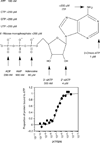Functional proteins from a random-sequence library
- PMID: 11287961
- PMCID: PMC4476321
- DOI: 10.1038/35070613
Functional proteins from a random-sequence library
Abstract
Functional primordial proteins presumably originated from random sequences, but it is not known how frequently functional, or even folded, proteins occur in collections of random sequences. Here we have used in vitro selection of messenger RNA displayed proteins, in which each protein is covalently linked through its carboxy terminus to the 3' end of its encoding mRNA, to sample a large number of distinct random sequences. Starting from a library of 6 x 1012 proteins each containing 80 contiguous random amino acids, we selected functional proteins by enriching for those that bind to ATP. This selection yielded four new ATP-binding proteins that appear to be unrelated to each other or to anything found in the current databases of biological proteins. The frequency of occurrence of functional proteins in random-sequence libraries appears to be similar to that observed for equivalent RNA libraries.
Figures




References
-
- Sassanfar M, Szostak JW. An RNA motif that binds ATP. Nature. 1993;364:550–553. - PubMed
-
- Wilson DS, Szostak JW. In vitro selection of functional nucleic acids. Annu. Rev. Biochem. 1999;68:611–647. - PubMed
-
- Cho G, Keefe AD, Liu RL, Wilson DS, Szostak JW. Constructing high complexity synthetic libraries of long ORFs using in vitro selection. J. Mol. Biol. 2000;297:309–319. - PubMed
Publication types
MeSH terms
Substances
Associated data
- Actions
- Actions
- Actions
- Actions
- Actions
- Actions
Grants and funding
LinkOut - more resources
Full Text Sources
Other Literature Sources

